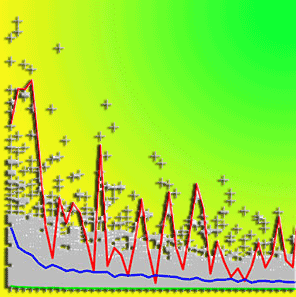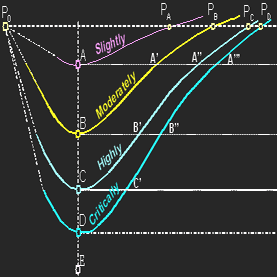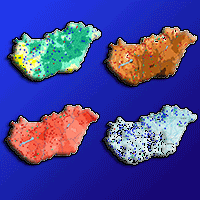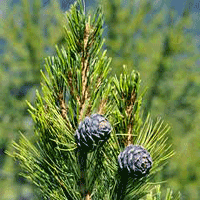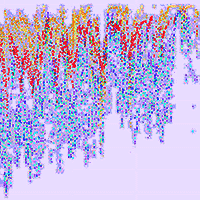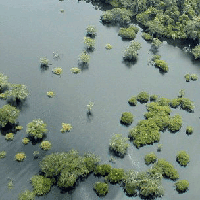Many ecological studies require long-term time series of high quality. Missing data may represent a serious problem since they can affect the reliability of measured variables in specific locations. To which extent and according to which methodology a gap in time series should be filled is a major research challenge. In this study, the time-series of meteorological data relative to 13 monitoring sites from the ICP-Forest network in Italy were analysed with the aim to define the minimum number of site-specific observations, which can be considered adequate for further analysis on forest resource management. Three main climatic variables were taken into account in the analysis: air temperature, relative humidity and total precipitation. By using an increasing proportion of available data, descriptive and inferential statistic methods were applied to evaluate the amount of variability along the period of analysis (1998-2013) and associated error of estimation at seasonal level. The relative importance of each factor accounted in our analysis (season, year, variable, plot, sampling proportion) was investigated fitting a Random Forest model on the results of the bootstrapping procedure. Air temperature was the variable with a marked seasonal profile and the easiest to be represented at monthly level on a specific time period. Humidity and precipitation were more stable across the analysed time period. Trends in precipitation showed that a high amount of variability could be detected only when > 80% of valid observations were available. Humidity showed an intermediate pattern, with an exponential increase in the amount of explained variability when using an increased proportion of sampled observations. Random Forest Regression models indicated sampling proportion (i.e., number of available observations) as an important factor for trend analysis of relative air humidity and precipitation. We conclude that monthly or seasonal statistics can be proficiently estimated for both air temperature and relative humidity with a proportion of missing values higher than 50%. Conversely, a reliable analysis of intra-seasonal or intra-monthly precipitation variability requires a much higher amount of observations. In the latter case gap filling represents the only feasible solution.
Keywords
, , , ,
Citation
Ferrara C, Marchi M, Fares S, Salvati L (2017). Sampling strategies for high quality time-series of climatic variables in forest resource assessment. iForest 10: 739-745. - doi: 10.3832/ifor2427-010
Academic Editor
Marco Borghetti
Paper history
Received: Mar 13, 2017
Accepted: Jun 27, 2017
First online: Aug 01, 2017
Publication Date: Aug 31, 2017
Publication Time: 1.17 months
© SISEF - The Italian Society of Silviculture and Forest Ecology 2017
Open Access
This article is distributed under the terms of the Creative Commons Attribution-Non Commercial 4.0 International (https://creativecommons.org/licenses/by-nc/4.0/), which permits unrestricted use, distribution, and reproduction in any medium, provided you give appropriate credit to the original author(s) and the source, provide a link to the Creative Commons license, and indicate if changes were made.

Breakdown by View Type
(Waiting for server response...)
Article Usage
Total Article Views: 49838
(from publication date up to now)
Breakdown by View Type
HTML Page Views: 42847
Abstract Page Views: 3050
PDF Downloads: 2996
Citation/Reference Downloads: 23
XML Downloads: 922
Web Metrics
Days since publication: 3058
Overall contacts: 49838
Avg. contacts per week: 114.08
Article Citations
Article citations are based on data periodically collected from the Clarivate Web of Science web site
(last update: Mar 2025)
Total number of cites (since 2017): 8
Average cites per year: 0.89
Publication Metrics
by Dimensions ©
Articles citing this article
List of the papers citing this article based on CrossRef Cited-by.
(1)
Allegrini MC, Canullo R, Campetella G (2009)ICP-Forests (International Co-operative Programme on Assessment and Monitoring of Air Pollution Effects on Forests): quality assurance procedure in plant diversity monitoring. Journal of Environmental Monitoring 11: 782.
CrossRef |
Gscholar
(2)
Amodei T, Guibal F, Fady B (2012)Relationships between climate and radial growth in black pine (
Pinus nigra Arnold ssp.
salzmannii [Dunal] Franco) from the south of France. Annals of Forest Science 70: 41-47.
CrossRef |
Gscholar
(3)
Barros C, Guéguen M, Douzet R, Carboni M, Boulangeat I, Zimmermann NE, Munkemuller T, Thuiller W (2017)Extreme climate events counteract the effects of climate and land-use changes in Alpine tree lines. Journal of Applied Ecology 54: 39-50.
CrossRef |
Gscholar
(4)
Bertini G, Amoriello T, Fabbio G, Piovosi M (2011)Forest growth and climate change: evidences from the ICP-Forests intensive monitoring in Italy. iForest - Biogeosciences and Forestry 4: 262-267.
CrossRef |
Gscholar
(5)
Bhowmik AK, Costa AC (2014)Representativeness impacts on accuracy and precision of climate spatial interpolation in data-scarce regions. Meteorological Applications 22: 368-377.
CrossRef |
Gscholar
(7)
Bretherton CS, Smith C, Wallace JM (1992)An intercomparison of methods for finding coupled patterns in climate data. Journal of Climate 5: 541-560.
CrossRef |
Gscholar
(8)
Bussotti F, Pollastrini M (2017)Traditional and novel indicators of climate change impacts on European forest trees. Forests 8 (4): 137.
CrossRef |
Gscholar
(9)
Di Salvatore U, Ferretti F, Cantiani P, Paletto A, De Meo I, Chiavetta U (2013)Multifunctionality assessment in forest planning at landscape level. The study case of Matese Mountain Community (Italy). Annals of Silvicultural Research 37: 45-54.
CrossRef |
Gscholar
(10)
Eilmann B, Rigling A (2012)Tree-growth analyses to estimate tree species’ drought tolerance. Tree Physiology 32: 178-187.
CrossRef |
Gscholar
(11)
Eischeid JK, Pasteris PA, Diaz HF, Plantico MS, Lott NJ (2000)Creating a serially complete, national daily time series of temperature and precipitation for the Western United States. Journal of Applied Meteorology 39: 1580-1591.
CrossRef |
Gscholar
(12)
Fady B, Aravanopoulos FA, Alizoti P, Mátyás C, Wühlisch G, Westergren M, Belletti P, Cvjetkovic B, Ducci F, Huber G, Kelleher CT, Khaldi A, Kharrat MBD, Kraigher H, Kramer K, Mühlethaler U, Peric S, Perry A, Rousi M, Sbay H, Stojnic S, Tijardovic M, Tsvetkov I, Varela MC, Vendramin GG, Zlatanov T (2016)Evolution-based approach needed for the conservation and silviculture of peripheral forest tree populations. Forest Ecology and Management 375: 66-75.
CrossRef |
Gscholar
(13)
Flint LE, Flint AL (2012)Downscaling future climate scenarios to fine scales for hydrologic and ecological modeling and analysis. Ecological Processes 1: 2.
CrossRef |
Gscholar
(14)
Hastie T, Tibshirani R, Friedman J (2008)The elements of statistical learning (2nd edn). Springer-Verlag, Stanford, CA, USA, pp. 763.
Gscholar
(15)
Isaac-Renton MG, Roberts DR, Hamann A, Spiecker H (2014)Douglas-fir plantations in Europe: a retrospective test of assisted migration to address climate change. Global Change Biology 20: 2607-2617.
CrossRef |
Gscholar
(16)
Kramer K, Ducousso A, Gömöry D, Hansen JK, Ionita L, Liesebach M, Lorent A, Schüler S, Sulkowska M, De Vries S, Von Wühlisch G (2017)Chilling and forcing requirements for foliage bud burst of European beech (
Fagus sylvatica L.) differ between provenances and are phenotypically plastic. Agricultural and Forest Meteorology 234: 172-181.
CrossRef |
Gscholar
(17)
Lelieveld J, Hadjinicolaou P, Kostopoulou E, Chenoweth J, El Maayar M, Giannakopoulos C, Hannides C, Lange MA, Tanarhte M, Tyrlis E, Xoplaki E (2012)Climate change and impacts in the Eastern Mediterranean and the Middle East. Climatic Change 114: 667-687.
CrossRef |
Gscholar
(18)
Marchetti M, Vizzarri M, Lasserre B, Sallustio L, Tavone A (2014)Natural capital and bioeconomy: challenges and opportunities for forestry. Annals of Silvicultural Research 38: 62-73.
CrossRef |
Gscholar
(19)
Marchi M, Castaldi C, Merlini P, Nocentini S, Ducci F (2015)Stand structure and influence of climate on growth trends of a Marginal forest population of
Pinus nigra spp.
nigra. Annals of Silvicultural Research 39: 100-110.
CrossRef |
Gscholar
(20)
Marchi M, Chiavetta U, Castaldi C, Ducci F (2017a)Does complex always mean powerful? A comparison of eight methods for interpolation of climatic data in Mediterranean area. Italian Journal of Agrometeorology 1: 69-72.
CrossRef |
Gscholar
(21)
Marchi M, Ferrara C, Bertini G, Fares S, Salvati L (2017b)A sampling design strategy to reduce survey costs in forest monitoring. Ecological Indicators 81: 182-191.
CrossRef |
Gscholar
(22)
Marchi M, Nocentini S, Ducci F (2016)Future scenarios and conservation strategies for a rear-edge marginal population of
Pinus nigra Arnold in Italian central Apennines. Forest Systems 25: e072.
CrossRef |
Gscholar
(23)
Perdinan P, Winkler JA (2014)Changing human landscapes under a changing climate: considerations for climate assessments. Environmental Management 53: 42-54.
CrossRef |
Gscholar
(24)
R Core Team (2017)R: a language and environment for statistical computing. R Foundation for Statistical Computing, Vienna, Austria.
Online |
Gscholar
(25)
Ramirez-Villegas J, Jarvis A (2010)Downscaling global circulation model outputs: the delta method. Decision and Policy Analysis Working Paper No. 1, CIAT Decision and Policy Analysis Working Paper, Policy Analysis 1: 1-18.
Online |
Gscholar
(26)
Rathgeber CBK, Longuetaud F, Mothe F, Cuny H, Le Moguédec G (2011)Phenology of wood formation: data processing, analysis and visualisation using R (package CAVIAR). Dendrochronologia 29: 139-149.
CrossRef |
Gscholar
(27)
Ray D, Bathgate S, Moseley D, Taylor P, Nicoll B, Pizzirani S, Gardiner B (2015)Comparing the provision of ecosystem services in plantation forests under alternative climate change adaptation management options in Wales. Regional Environmental Change 15: 1501-1513.
CrossRef |
Gscholar
(28)
Salvati L, Becagli C, Bertini G, Cantiani P, Ferrara C, Fabbio G (2016)Toward sustainable forest management indicators? A data mining approach to evaluate the impact of silvicultural practices on stand structure. International Journal of Sustainable Development and World Ecology 24 (4): 372-382.
CrossRef |
Gscholar
(29)
Savi F, Fares S (2014)Ozone dynamics in a Mediterranean Holm oak forest: comparison among transition periods characterized by different amounts of precipitation. Annals of Silvicultural Research 38: 1-6.
CrossRef |
Gscholar
(30)
Schneider T (2001)Analysis of incomplete climate data: estimation of mean values and covariance matrices and imputation of missing values. Journal of Climate 14: 853-871.
CrossRef |
Gscholar
(31)
Schueler S, Falk W, Koskela J, Lefèvre F, Bozzano M, Hubert J, Kraigher H, Longauer R, Olrik DC (2014)Vulnerability of dynamic genetic conservation units of forest trees in Europe to climate change. Global Change Biology 20: 1498-1511.
CrossRef |
Gscholar
(32)
Ummenhofer CC, Meehl GA (2017)Extreme weather and climate events with ecological relevance - a review. Philosophical Transactions of the Royal Society B: Biological Sciences 372: 20160135.
CrossRef |
Gscholar
(33)
Wallace JM, Smith C, Bretherton CS (1992)Singular value decomposition of wintertime sea surface temperature and 500-mb height anomalies. Journal of Climate 5: 561-576.
CrossRef |
Gscholar
(34)
Wang T, Hamann A, Spittlehouse DL, Murdock TQ (2012)ClimateWNA - High-resolution spatial climate data for western North America. Journal of Applied Meteorology and Climatology 51: 16-29.
CrossRef |
Gscholar
(35)
Williams MI, Dumroese RK (2013)Preparing for climate change: forestry and assisted migration. Journal of Forestry 111: 287-297.
CrossRef |
Gscholar
(36)
Ziche D, Seidling W (2010)Homogenisation of climate time series from ICP Forests Level II monitoring sites in Germany based on interpolated climate data. Annals of Forest Science 67: 804.
CrossRef |
Gscholar
